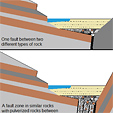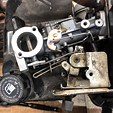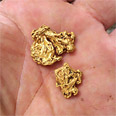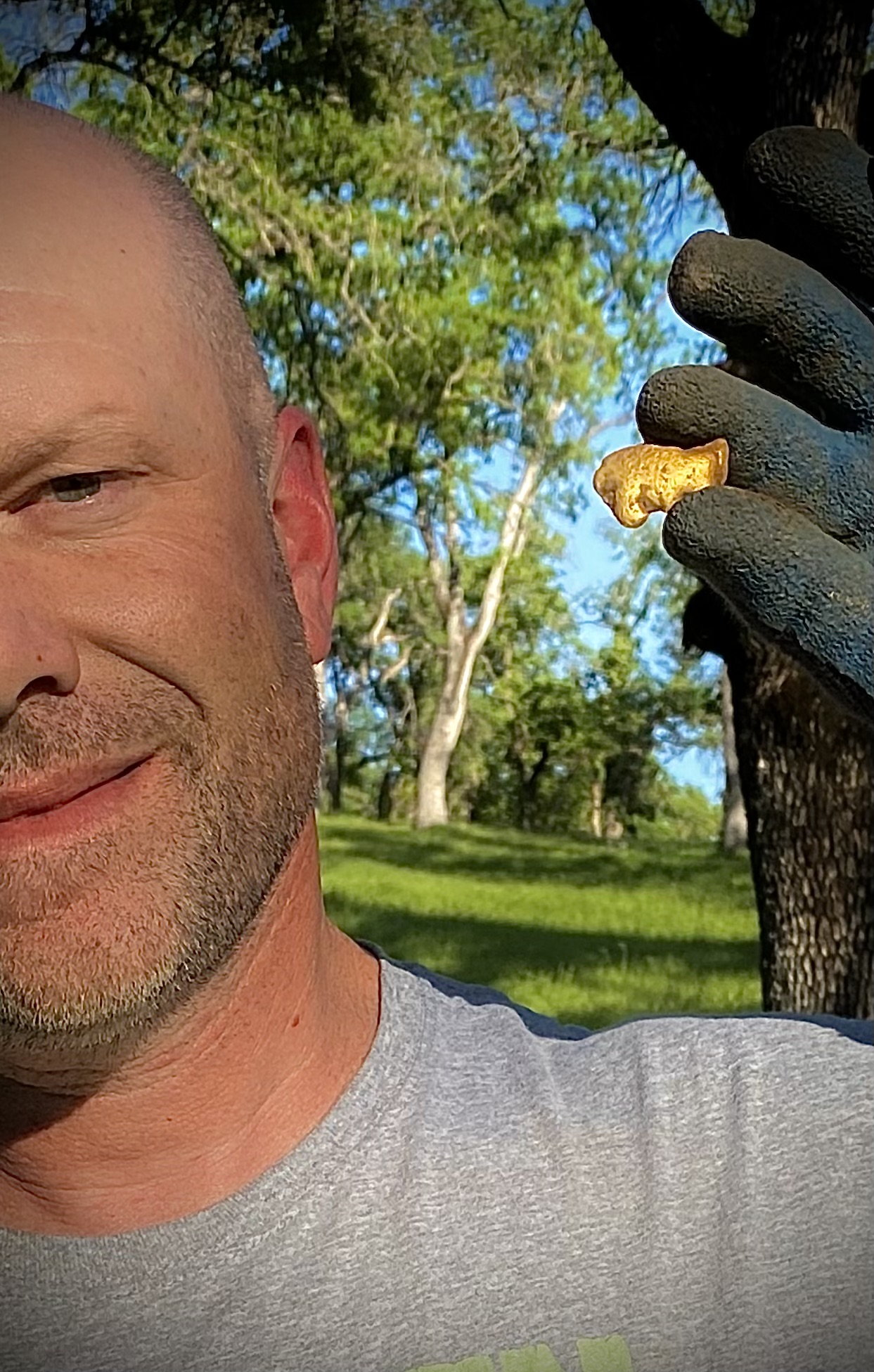Prospecting & Detecting
Large Gold Deposit Types
October 2018 by Chris Ralph
There are many types of gold deposits, but some are larger and more productive than most. In this series of articles, I am going to take a look at these geologic categories and how the prospector can join in the search for them. It’s important for individual prospectors to know something of the geology of these deposits. It is not necessary to have a PhD in geology, but you need to know the basics, so that’s what I am going to try to dig into here—the understandable basics of these gigantic gold deposits. In part two, I will go into more detail on where they are found and how one might explore for them.
The most productive gold deposits fall into six broad categories. I am going to go into an explanation of each of these, but first, let’s list them off. These are: 1) Orogenic type deposits; 2) Reduced intrusion related deposits; 3) Oxidized intrusion related deposits; 3) Carlin type; 4) Low sulfidation epithermal; 5) Gold-rich VMS deposits and 6) Witwatersrand deposits. Of these, the Witwatersrand type has yielded the most gold, but the oxidized intrusion related type is a close second. Of course, not every one of these deposits that have been found is gigantic, but of the really big gold producers around the world, the great majority of them fall into one of these categories. The prospector is searching for the footprints that will lead to one of these types of deposits, so we shall take a look at each type individually and talk about the characteristics that define each one and the types of regional settings in which they may be found.
Orogenic Type Gold Deposits
Although the name may be unfamiliar to prospectors, these are quartz carbonate veins and associated wall rock replacement deposits that are found in greenstone and slate belts. They are well known from places like the Mother Lode country of California, the Golden Triangle of Australia, and the greenstone belts of West Africa and Canada. They have also been called Mother Lode type and mesothermal quartz veins. The name “orogenic” means they are associated with episodes of mountain building. The same forces of regional tectonic plate compression that form mountain ranges also create fault and shear zone systems that give rise to these deposits.
These deposits are known for their formation at great depth and their vertical continuity, with ore bodies extending sometimes as much as 3,000 feet down dip. While many of these veins are small, they can also occur as a series of small stockwork veins or as larger veins up to 40 feet wide. Some of the veins can be very high in grade and rich pockets are not unusual. They are also characterized by minimal amounts of sulfide mineral content, and what is present is often in the form of pyrite or arsenopyrite. They have very little silver—often only a tiny fraction of the gold by weight. Small amounts of lead, zinc or copper sulfides may also be present.
 The greenstone belt hosted deposits have been the most important in this category overall, and many of the greenstone deposits are located at contacts of the greenstone and other rocks. Orogenic deposits are also found within banded iron formations associated with greenstone belts as at the Homestake gold mine near Lead, South Dakota. This class of deposits also includes turbidite hosted veins as at Bendigo, Australia, or Juneau, Alaska.
The greenstone belt hosted deposits have been the most important in this category overall, and many of the greenstone deposits are located at contacts of the greenstone and other rocks. Orogenic deposits are also found within banded iron formations associated with greenstone belts as at the Homestake gold mine near Lead, South Dakota. This class of deposits also includes turbidite hosted veins as at Bendigo, Australia, or Juneau, Alaska.
Reduced Intrusion Related
Reduced intrusion-related gold deposits have only become well recognized in the last few decades, and have become a new, low-grade, large-tonnage exploration target for many mining companies. Gold deposits related to reduced granitic intrusions are characterized by large zones of parallel, sheeted, gold-bearing quartz veins and veinlets that form along the fractured margins of small intrusive plutons. If the sheeted zone is large enough, they form bulk-tonnage, low-grade gold deposits that can be mined by open pit methods as at the Donlin, Fort Knox and Dublin Gulch deposits. The gold in these deposits can be fairly coarse and these sheeted vein systems can give rise to placers where they erode into the local streams.
A large number of the known placers with unrecognized sources in Alaska, Montana, Idaho and the Yukon likely come from undiscovered reduced intrusion related sources. The huge Donlin Creek deposit in Alaska was a small, moderately productive placer area until the huge hard rock deposits adjoining them were recognized. Because these deposits are generally low in grade overall (often less than 1 gram per ton) and the fact that they do not normally generate high-grade vein systems (like orogenic deposits), the low-grade placer sources were not recognized by old time prospectors as they were in other types of deposits.
The reduced state of the intrusive body that generates these deposits causes the associated sulfide minerals to be characterized by pyrrhotite instead of pyrite. The quartz veins also host methane-rich inclusion bubbles. Reduced intrusion related deposits form mostly at depths of about 3 to 4 miles and form from fluids that are low in salinity. These gold systems form far from the volcanic arcs of plate contacts, in continental margin settings dominated by older sediments that may be metamorphosed.
Gold is the dominant metal of interest in these deposits, though they are associated with bismuth, tellurium and arsenic. Deposits of tin and tungsten may be found in the same region. The granitic intrusive bodies that generate these deposits are formed later as post-orogenic intrusions that are relatively reduced chemically, alkaline-tending and volatile-rich. These plutons fracture the surrounding rocks as they are intruded and the parallel fractures created give rise to the sheeted vein systems that are characteristic of these deposits.
Oxidized Intrusion Related
Granitic rocks responsible for generating valuable gold deposits have a wide range of geochemical characteristics, and some geologists lump both reduced and oxidized intrusion-related deposits together. Early intrusion-related gold classifications were based on a gold-rich porphyry copper type of classification, but were later separated when the differences between oxidized and reduced intrusive types were recognized. Because they form generally different types of deposits, I am treating them separately for the purposes of this article.
The oxidized intrusion-related gold deposits include the well-known porphyry, skarn, and high-sulfidation epithermal classes of deposits. These tend to be associated with high-level, oxidized porphyry stocks in magmatic arcs. The gold is present in a stockwork of quartz veinlets occurring within diorite, tonalite, or dacite porphyry. This is normally emplaced in the core or flank of a stratovolcano or a volcanic dome-vent complex that creates igneous systems that are active for long periods of time. If a sufficient amount of the overlying volcanic rocks are still present, the system may show itself as a high sulfidation epithermal system of veins with advanced argillic alteration and vuggy silica replacement alteration. Many geologists now believe that essentially all high sulfidation epithermal systems are associated with underlying porphyry deposits. Skarn and other replacement deposits are also zoned in this type of mineral system, with copper-rich skarns generally located very close to the porphyry intrusion source.
 The oxidized intrusion-related gold systems are all directly associated with porphyry copper systems in one way or another, so their tectonic settings are the same. They are found within calc-alkaline intrusive arcs. All the gold in these deposits is always associated with at least some copper, and there is a full range of copper to gold ratios across this type. Because of this, the geologic features of these deposits are similar to those of porphyry copper deposits.
The oxidized intrusion-related gold systems are all directly associated with porphyry copper systems in one way or another, so their tectonic settings are the same. They are found within calc-alkaline intrusive arcs. All the gold in these deposits is always associated with at least some copper, and there is a full range of copper to gold ratios across this type. Because of this, the geologic features of these deposits are similar to those of porphyry copper deposits.
Low Sulfidation Epithermal
Epithermal ore deposits, by definition, form at shallow depths. Testing by geologists of fluid inclusions within the ore indicates that epithermal ores form at temperatures ranging from about 250° F to 600° F, and from the surface down to as deep as about one mile. Most low sulfidation (LS) epithermal gold deposits are found in intra-arc or back-arc rifts within continental or island arcs with bimodal volcanism. They are typically hosted in volcanic units, but can also be hosted by the surrounding basement sedimentary or metamorphic rocks.
Both low-grade disseminated and structurally controlled high-grade vein type deposits can form, such as at Round Mountain and the Comstock Lode in Nevada. In fact, Nevada is famous for its many LS epithermal deposits. They are generally divided into two types—one of veins that penetrate into the bedrock and the other being hot spring deposits that form like a blanket over the surface. Both are related and the hot springs can grade down dip into the vein type.
Productive vein type LS epithermal deposits are characterized by complex ore mineralogies, with gold, electrum, argentite and other silver-bearing minerals. Silver is typically much more abundant than gold. They have low base metal contents with minor galena and chalcopyrite, tetrahedrite and sphalerite. The veins exhibit vuggy, comb, and crustiform structures, with banded sulfide layers, quartz, calcite, and pyrite gangue minerals. Adularia is commonly present and sericite mica is also a common mineral.
 Hot spring-related LS epithermal deposits form where heated hydrothermal systems are active within a few hundred yards of the surface. Their geologic features include siliceous sinter, fumarole mineral precipitates, and hydrothermal eruption breccias as are commonly found around hot springs. These deposits typically have a higher gold-to-silver ratio and contain precious metals and sparse sulfides disseminated through a thick blanket of permeable tuffs or as stockworks in brittle rocks. Most have a significant content of mercury. The deeper levels of hot-spring deposits will have geologic characteristics more in common with epithermal veins, such as fault control, comb and banded veins, vuggy textures, and wall rock alteration.
Hot spring-related LS epithermal deposits form where heated hydrothermal systems are active within a few hundred yards of the surface. Their geologic features include siliceous sinter, fumarole mineral precipitates, and hydrothermal eruption breccias as are commonly found around hot springs. These deposits typically have a higher gold-to-silver ratio and contain precious metals and sparse sulfides disseminated through a thick blanket of permeable tuffs or as stockworks in brittle rocks. Most have a significant content of mercury. The deeper levels of hot-spring deposits will have geologic characteristics more in common with epithermal veins, such as fault control, comb and banded veins, vuggy textures, and wall rock alteration.
Carlin-Type Deposits
The term “Carlin-type” gold deposit (CT) was first used to describe the sediment-hosted gold deposits in central Nevada following the discovery of the Carlin mine in 1961. Carlin-type mineralization has been mined in Nevada since the 1930s, but was not recognized as a specific type of deposit to be searched for until a new batch of them were discovered beginning in the 1960s. They are now well known for their large tonnage and large gold production despite grades as low as 0.7 grams per ton gold (0.02 ounces per ton). Research is still being done and our understanding of these deposits continues to grow. Although they have been found in a number of locations, the largest and most significant Carlin-type deposits are located in Central Nevada. Current exploration for these deposits in Nevada is a search for buried and hidden ore bodies located below gravel cover and less favorable overburden rocks.
The deposits consist of disseminated gold in decalcified and silicified silty limestone and limy siltstone. Sediment-hosted gold deposits characteristically contain tiny microscopic gold grains only a few microns in size. In only a few very rare cases is the gold visible to the naked eye. At times the gold is localized along thin fractures and disseminated throughout sedimentary host rocks. In other cases, the mineralization consists of gold within the lattice of pyrite crystals. Commonly associated with the ores are realgar, orpiment and stibnite formed after the gold in fractures, veinlets and cavities. Geologists working along the Carlin Trend have established that the depth of formation for Carlin deposits is probably in the range of 0.5 to 2 miles deep.
Carlin-type deposits are distributed along well-defined mineral trends that are now understood to represent deep crustal breaks extending into the upper mantle. They are found where mineralizing fluids reacted with favorable carbonate rocks or in situations where mineral fluids were trapped below impervious rocks above them. The carbonate rocks that host the deposits are positioned below Paleozoic, deep-water sedimentary rocks that have been repeatedly thrust over them from the west during late mountain building events. This activity resulted in the development of many low-angle structures and open folds. Many of these deposits are situated on or close to the Roberts Mountains thrust fault. Thrust faulting both on a regional scale (as with the Roberts Mountains thrust) and smaller thrusts locally around the deposits are thought to be important. Deep, high-angle normal faults are also important controls of mineralization, allowing the movement of mineralized fluids upward into reactive host rocks. No igneous rocks around these deposits are recognized as obvious heat sources for their formation.
Gold-Rich VMS Deposits
Volcanogenic Massive Sulfide (VMS) deposits are best known as sources of base metals like zinc and copper, but can also be important sources of gold and silver. These deposits form on the ocean floor around sea floor spreading sites. Molten rock comes close to the surface and drives the circulation of hot water through faults and cracks in the rock. This process has been observed in action by scientists and the point of release into the ocean is called a “black smoker.” This black smoke is mostly sulfide minerals, and they accumulate on or close to the ocean floor to become VMS deposits. In the tectonic process of the earth’s plates being pushed around, some are eventually pushed up onto land where they become mineral resources.
 These deposits are characterized by abundant iron sulfides (like pyrite or pyrrhotite) and lesser amounts of chalcopyrite and sphalerite. Some deposits may also contain minerals such as bornite, tetrahedrite, galena and barite. Precious metals in the deposits are variable and may represent a small byproduct all the way up to being the major commodity. VMS ore bodies typically have mound or sheet-like form. Many (but not all) deposits overlie sulfide-bearing vein systems (called stringer or stockwork zones) which were the fluid flow conduits during their formation. Extensive rock alteration zones around these deposits reflect hydrothermal circulation through the footwall volcanic rocks.
These deposits are characterized by abundant iron sulfides (like pyrite or pyrrhotite) and lesser amounts of chalcopyrite and sphalerite. Some deposits may also contain minerals such as bornite, tetrahedrite, galena and barite. Precious metals in the deposits are variable and may represent a small byproduct all the way up to being the major commodity. VMS ore bodies typically have mound or sheet-like form. Many (but not all) deposits overlie sulfide-bearing vein systems (called stringer or stockwork zones) which were the fluid flow conduits during their formation. Extensive rock alteration zones around these deposits reflect hydrothermal circulation through the footwall volcanic rocks.
Sometimes geologists focus too closely on the base metal aspect of these deposits since these are normally the most important VMS minerals. Some VMS deposits contain very significant amounts of gold that may get overlooked. Only this year I heard about a VMS deposit that was mined in the late 1960s that was worked for copper. Overlying the sulfide-rich copper deposit was a layer of manganese-rich jasper—silica rock. At the time of mining, this rock was considered waste since it had no copper, so the mining company put it all in the dump. In recent decades some of this material was found around the old mine and tested by assay. It was found to be a fairly good grade of gold ore, but it was too late to extract the gold as it was spread throughout the waste dumps.
Witwatersrand (Paleo-placer) Deposits
There is still some small amount of debate among geologists as to the origin of the famous Witwatersrand gold deposits of South Africa, but most firmly believe these deposits reflect the remains of an ancient placer deposit. These deposits are rightfully famous, as they have produced about 50% of all the gold ever mined on earth.
 These deposits formed in an ancient basin where rivers dumped their sediments. The rivers formed deltas with many interconnecting, slow, flowing channels. All the heavy materials brought down from the mountains above were deposited, including large pebbles and heavy minerals, such as gold, pyrite, and the uranium mineral uranite. The mountains through which the rivers flowed were rich in gold-bearing greenstone belts. For the next 200 million years, this basin flood plain was repeatedly inundated, sometimes eroded, and later more sediments were deposited. This formed an 8,000-foot-thick layer of rock that is termed the “Central Rand Group.” It is this Central Rand Group that contains most of the gold-bearing conglomerate rock. The deposition of the Central Rand Group was eventually brought to an abrupt end by a massive outpouring of lava. The basin later filled with sediments and was buried. During burial, the gravels were changed by heat and pressure, turning them to solid rock and moving the gold around a bit within the layers. In 1884, the first discoveries were made, leading to a gold rush in 1886. The region still continues to produce millions of ounces of gold each year.
These deposits formed in an ancient basin where rivers dumped their sediments. The rivers formed deltas with many interconnecting, slow, flowing channels. All the heavy materials brought down from the mountains above were deposited, including large pebbles and heavy minerals, such as gold, pyrite, and the uranium mineral uranite. The mountains through which the rivers flowed were rich in gold-bearing greenstone belts. For the next 200 million years, this basin flood plain was repeatedly inundated, sometimes eroded, and later more sediments were deposited. This formed an 8,000-foot-thick layer of rock that is termed the “Central Rand Group.” It is this Central Rand Group that contains most of the gold-bearing conglomerate rock. The deposition of the Central Rand Group was eventually brought to an abrupt end by a massive outpouring of lava. The basin later filled with sediments and was buried. During burial, the gravels were changed by heat and pressure, turning them to solid rock and moving the gold around a bit within the layers. In 1884, the first discoveries were made, leading to a gold rush in 1886. The region still continues to produce millions of ounces of gold each year.
Mining companies are still exploring for gold in ancient placers in various places around the world since the Witwatersrand has been so productive. Ancient placer gold deposits have also been mined in the Tarkwaian gravel system of Ghana and in the Jacobina mine of east-central Brazil. Current exploration of ancient placers is also going on in the Pilbara region of Western Australia.
Next month I will continue this series with information on how the exploration for these potentially gigantic deposits is proceeding, and how the individual prospector can get involved in the search.

Using Structural Clues to Locate Buried Placer Channels
 They must have assumed the paystreak was spotty and had been mined out, so they never mined as close to the side of the valley as they should have.
They must have assumed the paystreak was spotty and had been mined out, so they never mined as close to the side of the valley as they should have.
Tips and Tricks: Preparing Your Dredge Engine for Storage
 From this I inferred that engine 2 had a carburetor problem. In this article, I discuss the specific engine/carburetor problem, and the surprising solution to this problem.
From this I inferred that engine 2 had a carburetor problem. In this article, I discuss the specific engine/carburetor problem, and the surprising solution to this problem.
Detecting for Gold—Finding Nuggets Where You Least Expect Them
 Many friends have come up to my locale to detect for gold. I am writing this article hoping that it may help anyone who uses a detector to prospect for gold nuggets.
Many friends have come up to my locale to detect for gold. I am writing this article hoping that it may help anyone who uses a detector to prospect for gold nuggets.
Gold Detecting Strategies for Hydraulic Mines and Debris Flows
 The old timers typically washed these areas down to bedrock, and some areas appear terraced. I would imagine this is because these hydraulic mines were generally where the miners found old Tertiary river channels on the sides of mountains that were gold-bearing.
The old timers typically washed these areas down to bedrock, and some areas appear terraced. I would imagine this is because these hydraulic mines were generally where the miners found old Tertiary river channels on the sides of mountains that were gold-bearing.
Crystallized Gold Mines of California
 Gold specimens that include visible crystal formations are among the rarest, most attractive and most valuable forms of gold to be found.
Gold specimens that include visible crystal formations are among the rarest, most attractive and most valuable forms of gold to be found.
Our Readers Say
- Conversion charts and tables
- Solutions to anti-mining efforts
Subscription Required:
Free:
The Bawl Mill
• Legislative and Regulatory Update
• Ask The Experts - A few questions about 'peak gold'
• Ask The Experts - Seeking advice on processing pocket gold
• Ask The Experts - How do I recover gold in pyrite?
• Ask The Experts - Can a British citizen purchase a mining claim?
• Ask The Experts - Is California dredging going to return in 2019?
• Ask The Experts - Were you aware of the new recording fee in California?
• The Unusual Forest Nugget Patch
• California Sniping
• PLP Update
• A Father’s Day to Remember: 24,000 Ounces Gold in Quartz
• How to Beat the Heat--and The Bedrock
• Gold Prospecting: For Better or Worse--It Was A Dark and Overcast Night
• Using Geologic Publications to Discover Collecting Sites
• Prospector Unearths Huge 'Duck’s Foot' Nugget
• Melman on Gold & Silver
• Mining Stock Quotes and Mineral & Metal Prices









